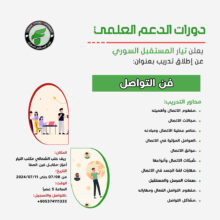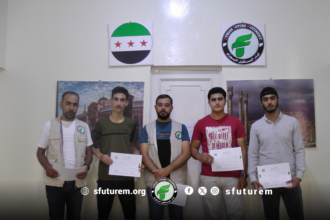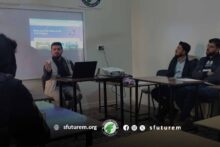
Introduction:
The reconstruction project is a comprehensive and large-scale process aimed at restoring and repairing the damage caused to a country or region as a result of war, a natural disaster, or any other event that destroyed infrastructure, public, and private property.
The main goals of the reconstruction project include restoring basic services, such as rehabilitating essential services like water, sanitation, electricity, roads, bridges, hospitals, and schools. In addition, it aims to revive the economy by reinvigorating various economic sectors such as agriculture, industry, trade, and tourism.
Another goal is to restore the social fabric by rebuilding the affected communities through providing humanitarian aid, resettling displaced people in their homes, and restoring public facilities. The project also involves creating new job opportunities through reconstruction projects. Lastly, but not least, it aims to enhance stability and contribute to achieving political and social stability in the affected area.
Elements and Challenges of the Reconstruction Project:
The reconstruction project is based on conducting a comprehensive assessment of the damage to infrastructure and property to determine the needs, and drafting detailed reconstruction plans that set priorities, budgets, and a timeline for the implementation of projects.
It also involves securing the necessary funding for the implementation of projects through various funding sources such as international aid, loans, and grants. Furthermore, the project requires the implementation of projects according to the plans, ensuring quality and efficiency, as well as monitoring the progress of work and evaluating the performance of projects to ensure the achievement of the desired goals.
Challenges of the Reconstruction Project:
- High costs: Reconstruction projects require enormous investments that may be difficult to gather even with international support.
- Long duration: The reconstruction process takes a long time.
- Logistical challenges: Reconstruction projects face significant logistical challenges, especially in remote areas.
- Political challenges: Political conflicts and disputes may hinder reconstruction projects.
An example of a reconstruction project is the “Lebanon Reconstruction Project after the Civil War,” which is an example of a large-scale reconstruction project that lasted for several years and involved rebuilding infrastructure, public facilities, and reviving the economy.
Reconstruction in Syria:
The reconstruction project in Syria represents one of the biggest contemporary challenges in the region, if not the world, with an estimated cost of one trillion dollars! This is due to the long years of bloody conflict that destroyed infrastructure and public facilities, and displaced millions of people.
The importance of reconstruction in Syria lies in:
- Restoring stability: Reconstruction is a crucial step in restoring political and social stability in Syria.
- Reviving the economy: Reconstruction would stimulate the Syrian economy and create new job opportunities.
- Improving living standards: It contributes to improving the standard of living for Syrian citizens and providing essential services.
- Preventing migration: It helps prevent mass migration waves of Syrians.
- Enhancing regional security: The project contributes to enhancing security and stability in the region.
The challenges facing reconstruction in Syria can be summarized as:
- Poor security situation: Ongoing armed conflict in some areas represents a significant obstacle to the reconstruction process.
- Economic crisis: The Syrian economy is suffering from a severe crisis, reducing its ability to provide the necessary funding for reconstruction.
- Corruption: The widespread corruption threatens the loss of funds allocated for reconstruction.
- Mass displacement: The displacement of millions of Syrians poses a significant challenge in resettling the population and rebuilding communities.
- Political disputes: Disputes and conflicts between Syrian factions and their supporting countries complicate the reconstruction process.
- Economic sanctions: Many countries have imposed economic sanctions on the Syrian regime, limiting Syria’s overall ability to obtain the necessary funding for reconstruction.
The essential elements of the Syrian Reconstruction Project include:
- Conducting a comprehensive assessment of the damage to infrastructure and property to determine needs.
- Drafting detailed reconstruction plans that set priorities, budgets, and a timeline for the implementation of projects.
- Securing the necessary funding for project implementation from various funding sources such as international aid, loans, and grants.
- Implementing the projects according to the plans, ensuring quality and efficiency.
- Monitoring the progress of work and evaluating project performance to ensure the achievement of the desired goals.
Mechanisms to Attract Investments:
This can be done through:
- Providing a safe and stable environment by improving the security situation and ensuring protection for investors and their properties.
- Building advanced infrastructure by developing road networks, transportation, energy, water, and sanitation services.
- Providing investment incentives by offering tax incentives, customs facilities, and affordable industrial lands.
- Investment marketing through organizing events to promote investment opportunities in Syria.
- Building international partnerships through cooperation with international organizations and attracting foreign direct investments.
Future challenges for the reconstruction project in Syria include:
- Funding: Funding remains the biggest challenge to the reconstruction process.
- Corruption: Corruption threatens the loss of funds allocated for reconstruction.
- Political conflicts: Ongoing political disputes may continue to hinder the reconstruction process.
- Climate change: Climate change could impact reconstruction efforts and increase environmental challenges.
Reconstructing Syria is a complex and long-term process that requires the combined efforts of the international community, the Syrian regime, other authorities in power, and the private sector to lay the groundwork for the project. Despite the significant challenges, reconstruction represents a historic opportunity to rebuild and develop Syria.
It is also important to emphasize:
- Any investment in Syria should be sustainable and considerate of local interests.
- There should be a fair distribution of the economic returns from investments.
- There should be transparency in all procedures related to investment.
Current Capabilities:
The question of whether Syria can be rebuilt without a political solution is a pivotal and complex one, requiring an in-depth analysis of the Syrian situation.
To explore this question, we can consider several aspects:
- Nature of the destruction: The destruction in Syria is not just physical destruction of infrastructure but also includes deep social and political destruction. This means that physical rebuilding alone will not be sufficient; the root causes of the conflict must also be addressed.
- Trust: It is impossible to attract the massive foreign investments needed for reconstruction without a certain level of trust in future political stability. Any major reconstruction process will require a broad agreement between Syrian parties and supporting countries.
- Resource distribution: How will reconstruction resources be distributed? Will they only go to areas controlled by the Syrian regime, or will they include other areas? This is a very sensitive issue directly related to the political solution.
- Accountability: There must be a mechanism to hold those accountable for the violations committed during the war, which requires a political solution that guarantees transitional justice.
- Small and medium-sized projects: Small and medium-sized projects can contribute to reconstruction, but they will not be sufficient to rebuild major infrastructure.
Therefore, it is difficult to envision a comprehensive and sustainable reconstruction process in Syria without a political solution. A political solution is the foundation for building trust, restoring stability, attracting investments, and distributing resources fairly.
However, there are some opinions that see the possibility of starting some small and medium-sized reconstruction projects gradually, even before reaching a full political solution. However, these projects must be carefully studied, considering the existing security and political challenges.
It can be said that reconstruction without a political solution is possible, but it will be limited and unsustainable. The best solution is to link the reconstruction process to a comprehensive political path, as the implementation of reconstruction projects in Syria under the current conditions represents a significant challenge but is not impossible. It requires careful planning and international and regional cooperation, considering the complex security, political, and economic challenges.
Some proposals for implementing reconstruction projects in Syria include:
- Setting priorities: The initial focus should be on projects that directly improve people’s lives, such as:
- Rehabilitating basic infrastructure like water, sanitation, roads, and electricity.
- Rehabilitating hospitals and schools to provide essential healthcare and educational services.
- Providing humanitarian aid to meet the basic needs of those affected by the war.
- International and regional cooperation: Mobilizing international and regional support to fund and implement reconstruction projects. Mechanisms can be created for coordination between donor countries, international organizations, and NGOs.
- Community participation: Engaging the local community in the planning and implementation of reconstruction projects to ensure the sustainability of these projects and meet the needs of local residents.
- Combating corruption: Establishing effective and advanced mechanisms with the assistance of developed countries to combat corruption to ensure that aid reaches the real beneficiaries.
- Building trust: Building trust between different Syrian parties and between Syria and donor countries through dialogue, negotiation, and resolving existing disputes, even without reaching a comprehensive solution.
- Focusing on small and medium-sized projects: Starting with small and medium-sized projects in various economic sectors, such as agriculture, industry, and trade, to create job opportunities and stimulate economic growth.
- Linking reconstruction to a comprehensive political solution aimed at achieving a peaceful political transition in Syria, thus making reconstruction a cause rather than a condition.
Negatives of the Reconstruction Project:
Although the reconstruction of Syria appears to be an urgent necessity to restore the country to its former state, it also carries with it numerous negatives and challenges that could impact the reconstruction process and Syria’s future. Some of the most important downsides we see are:
- Entrenchment of the existing regime: The reconstruction process might be used as a tool to reinforce the current political regime and strengthen its power without implementing genuine reforms or achieving transitional justice.
- Marginalization of large segments of society: Certain groups may benefit from the reconstruction at the expense of others, leading to increased social disparities and deepening divisions.
- Exacerbation of corruption: The reconstruction process may open the door to further corruption and the misuse of public funds, negatively affecting the progress of projects and depriving citizens of expected benefits.
- Exploitation by foreign powers: Foreign countries could exploit the reconstruction process to achieve their own interests and expand their influence in Syria, undermining the sovereignty of the state and its national decision-making, and moving away from a comprehensive solution.
- Perpetuation of the status quo: The reconstruction process could stabilize the current situation and postpone any deep political resolutions to the Syrian crisis.
- Ignoring the causes of the war: Focusing on physical reconstruction while neglecting to address the root causes of the war increases the risk of renewed conflict in the future.
- Alteration of identity: Reconstruction could lead to changes in the cultural and historical identity of Syrian cities, erasing their civilizational landmarks.
- Ballooning debt: The accumulation of large debts resulting from the reconstruction efforts could place a significant burden on future Syrian generations.
- Environmental degradation: Some reconstruction projects could contribute to environmental degradation and the pollution of natural resources.
Can Syria recover without these projects?
The possibility of Syria recovering without comprehensive reconstruction projects is a complex question that requires a deep analysis of the Syrian situation. It is extremely difficult, if not impossible, for Syria to fully and permanently recover without such comprehensive projects. Why?
- The Syrian war has caused widespread destruction of infrastructure, buildings, cities, and agricultural fields, making it nearly impossible to resume normal life and provide essential services to citizens without rebuilding this infrastructure.
- The war has devastated the Syrian economy, leading to high unemployment and poverty rates. Rebuilding infrastructure and productive projects is a necessary step to revive the economy and create job opportunities.
- Millions of Syrians have been displaced, and rebuilding homes and communities is essential for the return of refugees and displaced people.
- Reconstruction can help achieve political stability by providing jobs and improving living conditions, which in turn reduces social tensions.
Conclusion:
Reconstruction in Syria is a priority for both the foreign powers involved in Syria’s affairs and for Syrians from various segments of society. However, to ensure that reconstruction projects serve the interests of the Syrian people, we, in the Economic Office of the Syrian Future Movement (SFM), recommend the following:
To ensure that the reconstruction projects in Syria are truly beneficial for Syrians, they must include several key elements:
- Community participation: Local communities should be central partners in the planning and implementation process. It is essential to consult local residents about their needs and priorities and enable them to participate in decision-making that affects their lives.
- Justice and equality: Reconstruction projects should be fair and equitable, ensuring that all regions and population groups benefit without discrimination. It’s crucial to avoid focusing on certain areas at the expense of others or marginalizing certain segments of society.
- Sustainability: Reconstruction projects must be environmentally, economically, and socially sustainable. It is necessary to choose technologies and methods that preserve natural resources and support sustainable economic development.
- Institution building: The reconstruction process should contribute to the establishment of strong and transparent institutions capable of delivering public services efficiently and effectively.
- Focus on people: Reconstruction projects should be human-centered, aiming to improve living standards and achieve human development.
- Transparency and accountability: The reconstruction process must be transparent and subject to accountability, with clear dissemination of information about how funds and resources are being spent, allowing for media scrutiny and international auditing.
- Integration with comprehensive development plans: Reconstruction projects should be linked to long-term comprehensive development plans that contribute to sustainable development.
- Address the root causes of the conflict: Reconstruction should tackle the underlying causes of the conflict, such as social and economic inequalities, corruption, and poor governance.
References:
- Ali Muhammad Al-Khouri, Reconstruction as a Gateway to Activating Arab Economic Integration and Joint Action, Arab Economic Unity Council, Egypt, 2019.
- Huwaida Al-Harithy, Lessons in Reconstruction: Case Studies from Lebanon in the Aftermath of the 2006 War, Routledge, 2010.
- Sultan Barakat, Shelter and Reconstruction after Conflicts and Disasters, Hamad Bin Khalifa University, 2023.
- إعادة الإعمار في الدول العربية بعد الحرب: استمرار الصراع بوسائل أخرى
- إعادة الإعمار كسلاح
- مبادئ حقوق الإنسان في سوريا تحت مُسمَّى إعادة الإعمار: الدروس المُستفادة لسوريا مِن شركة سوليدير-بيروت
- صندوق الائتمان لإعادة إعمار سوريا
- سوريا ما بعد الحرب.. دول تتهافت على إعادة الإعمار
- عن ‘إعادة إعمار سوريا’
Jacqueline K. Al-Shami
Economic Office
Research and Studies Department
Articles
Syrian Future Movement (SFM)






